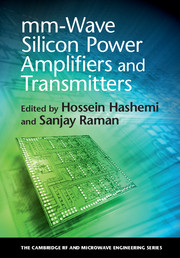Book contents
- Frontmatter
- Contents
- List of Contributors
- Preface
- 1 Introduction
- 2 Characteristics, performance, modeling, and reliability of SiGe HBT technologies for mm-wave power amplifiers
- 3 Characteristics, performance, modeling, and reliability of CMOS technologies for mm-wave power amplifiers
- 4 Linear-mode mm-wave silicon power amplifiers
- 5 Switch-mode mm-wave silicon power amplifiers
- 6 Stacked-transistor mm-wave power amplifiers
- 7 On-chip power-combining techniques for mm-wave silicon power amplifiers
- 8 Outphasing mm-wave silicon transmitters
- 9 Digital mm-wave silicon transmitters
- 10 System-on-a-chip mm-wave silicon transmitters
- 11 Self-healing for silicon-based mm-wave power amplifiers
- Index
- References
2 - Characteristics, performance, modeling, and reliability of SiGe HBT technologies for mm-wave power amplifiers
Published online by Cambridge University Press: 05 April 2016
- Frontmatter
- Contents
- List of Contributors
- Preface
- 1 Introduction
- 2 Characteristics, performance, modeling, and reliability of SiGe HBT technologies for mm-wave power amplifiers
- 3 Characteristics, performance, modeling, and reliability of CMOS technologies for mm-wave power amplifiers
- 4 Linear-mode mm-wave silicon power amplifiers
- 5 Switch-mode mm-wave silicon power amplifiers
- 6 Stacked-transistor mm-wave power amplifiers
- 7 On-chip power-combining techniques for mm-wave silicon power amplifiers
- 8 Outphasing mm-wave silicon transmitters
- 9 Digital mm-wave silicon transmitters
- 10 System-on-a-chip mm-wave silicon transmitters
- 11 Self-healing for silicon-based mm-wave power amplifiers
- Index
- References
Summary
Introduction
SiGe BiCMOS technology is an excellent choice for RF (radio frequency) and mm-wave applications as it combines the best features of CMOS logic, high-performance SiGe heterojunction bipolar transistors (SiGe HBTs), and RF passives like transmission lines, capacitors, inductors, Schottky barrier diodes (SBDs), p-i-n diodes, and resistors. RF models for all of these devices and process design kits are readily available for the design and simulation of RF circuits. In addition, BiCMOS technologies generally support multiple HBTs having different breakdown voltage, noise, and performance specifications for varied applications.
The selection of any technology for mm-wave applications like power amplifiers (PAs) or transmitters is dependent not only on the performance of the technology but more so on the economics and total cost of the project integration. Compound semiconductor HBTs like InP and GaAs have better cut-off frequencies and breakdown voltage but lose to silicon technologies in terms of cost and integration. RFCMOS technologies may have similar performance specifications to the SiGe HBTs but BiCMOS is still preferred over RFCMOS for several reasons. At the same lithography node, SiGe HBT has superior performance and breakdown voltage to the CMOS devices. For equal performance CMOS requires much more aggressive lithography (>n + 2 gen) and as such is significantly more expensive than SiGe BiCMOS. SiGe HBTs have a higher breakdown voltage and power handling capability, higher operating voltage, higher self-gain, better voltage swing, better impedance matching, and better linearity than CMOS. This chapter will explore these and other aspects of the SiGe BiCMOS technology that make it ideal for silicon mm-wave applications like power amplifiers and transmitters.
The chapter begins with a basic graded-base SiGe HBT device physics description followed by a discussion about the processing technology used to fabricate the device emphasizing aspects that impact high-performance mm-wave SiGe HBTs. A detailed comparison of performance trends across various technologies and industries is presented next. For mm-wave circuits there is an additional set of metrics such as breakdown voltage, noise figure, linearity, and thermal effects which are key to mm-wave applications. Several sections are devoted to discussion of breakdown voltage, thermal effects, and noise figure. In addition to the SiGe HBT transistors, silicon RF passives are also important and there is a discussion on Schottky diodes, PIN diodes, and other passives readily available in BiCMOS technologies.
- Type
- Chapter
- Information
- mm-Wave Silicon Power Amplifiers and Transmitters , pp. 17 - 76Publisher: Cambridge University PressPrint publication year: 2016
References
- 1
- Cited by



